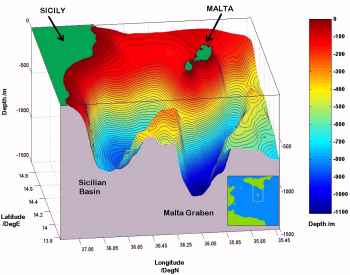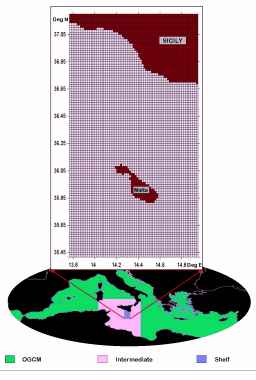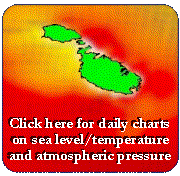| |
| The
PO-Unit has implemented a high resolution hydrodynamical model
of the Malta shelf area. This work was carried out as part
of the Mediterranean Forecasting System Pilot Project (MFSPP)
funded under the IVth Framework Programme of the EU. The model
was run with perpetual year forcing for three years to reach
a repeating seasonal cycle.The shelf model is capable to reproduce
the major dynamical features of the known climatological circulation.
Several numerical simulations were conducted to optimise the
nesting procedure between models at different resolutions
in order to downscale the hydrodynamics from the OGCM (General
Circulation Model of the |
 |
| Three
- dimensional view of the model bathymetry |
| Click
image to enlarge |
|
| Mediterranean)
to an intermediate coarser model (developed by the Italian partner
at IMC in Sardinia) and to the shelf model. |
The main research effort consisted
also in assessing different initial conditions from the coarser
model, time frequency of updating and kind of open boundary conditions,
surface flux corrections and the heat penetration laws.
Full details on the model are published in:
DRAGO A., SORGENTE R. & RIBOTTI A. (2002),
A high resolution hydrodynamical 3D model of the Malta Shelf
area, to appear in Annales Geophysicae.
|
This
work has prepared the way towards ocean forecasting in the
Malta shelf area to be implemented in the next phase of MFSPP.
In this new project the shelf model will approximately double
the spatial resolution in order to arrive at a grid mesh of
less than 1Km. This new model configuration is expected to
greatly improve the forecast skill. The work will also address:
i) the effects of downscaled atmospheric
forcing (very high resolution winds) in improving the models’
forecast skill.
ii) the improvement of sea level prediction
in particular Mediterranean regions by including atmospheric
pressure and tidal forcing.
iii) the effects of different air-sea
coupling strategies on the models’ forecast skill.
Work on the shelf
model is expected to lead to forecasting simulations which
will furnish weekly predictions in 3D of key physical parameters
(including sea temperature, salinity, currents and mixed layer
depth) in the Maltese coastal waters. |
 |
| The
model gridded domain and its nesting to the intermediate
model and the Ocean General Circulation Model of the
Mediterranean. |
|
Click
image to enlarge |
|
| |
|






